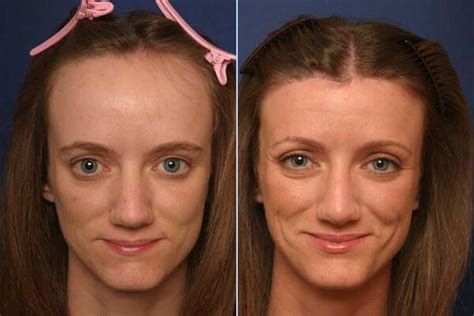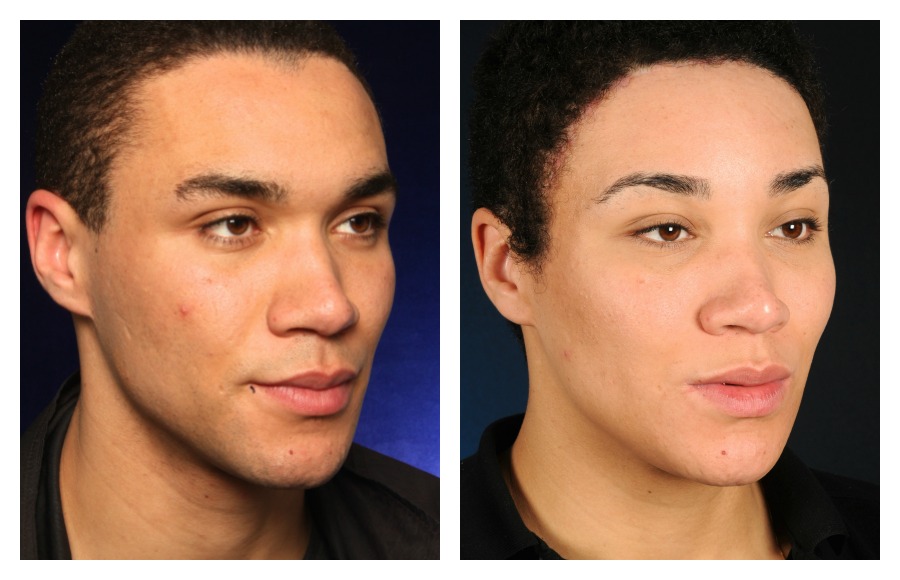Also known as Forehead Reduction, Forehead Contouring or Scalp Advancement, Hairline Lowering Surgery allows patients to lower their frontal hairline and is most common among women with high hairlines, often the result of hair loss.
The procedure usually takes a couple of hours and is performed under general anesthetic as an outpatient. The new hairline is marked on the forehead, the surgeon will cut away this excess skin and the scalp is lowered to the new hairline. Incisions are strategically placed so as to minimize the visibility of the scar, making it virtually undetectable as it’s covered by hair. It’s common to combine hair lowering surgery with Facial Feminization Surgery (FFS).

The Procedure
Contents
It is an outpatient procedure performed under local or general anesthesia. Before the operation begins, the surgeon draws an anticipated post-operative hairline. The surgery is performed according to this and an incision is made along the hairline. The excessive scalp is cut and removed and the rest is stretched to the new hairline. If this is not enough, tissue expanders are used to make it to the new hairline level. Sutures are used to fix the scalp to the bone and incisions are stitched with bandages being applied over the top. The incisions are placed where the hair can regrow, making the scars invisible. With further growth of the hair, scars will completely disappear from view.
Length of Stay in Destination
Hairline lowering surgery is an outpatient procedure that takes around 1.5 to 2 hours to complete in the operation theatre. After the effects of the sedation subside, you are allowed to leave. Still, you should aim to stay in the country for at least 6 days post-op. During this period, you will have a follow-up with the surgeon to check everything is healing as expected and the sutures are removed, usually after 5 to 6 days – this is when you’re given the all-clear to travel home.
Recovery Time
It will take between 3 to 6 months to allow the regrowth of hair through the scar, which is important as it hides the scar. Recovery time varies from person to person and some people can get back to their normal routine even after 2 days. 6 to 7 days are usually required to get back to normal activities and you may find some swelling and bruising over your forehead in the early days. Pain is managed with painkillers and all symptoms subside after a couple of days. A numbing of the forehead is common and normal feeling usually returns after 3 to 5 days.
Aftercare
The following are some useful aftercare tips:
- Use icepacks in the initial days to help with inflammation and bruising. Ice is effective in reducing swelling immediately.
- Do not take anti-inflammatory medicines as they increase bleeding tendency.
- Continue taking painkillers prescribed by your doctor.
- Try not to look upwards and avoid frowning as this can be damaging to your stitches.
- Do not lift heavy objects.
- Keep your head a little higher whilst resting.
- Ensure that tight bandages have been applied over the wounds and replace regularly with fresh ones.
- Do not take a bath when the bandages are still intact as a wet bandage can be the cause of infection.
- Avoid strenuous activities such as the gym, running, swimming, etc. for at least 2 weeks after the surgery.
- Do not put hair bands or any other accessory on your head for some time.
- Do not drink or smoke as it will hinder the healing process.
- Ensure you have a diet rich in vitamin C as it makes the healing process faster.
Success Rate
The success rate is very high for hairline lowering procedures and the side effects are minimal, but it’s worth considering that the scar may be visible with certain hairstyles. Hair Transplantation could be applied to further reduce the appearance of any scarring. As hairline lowering surgery becomes more popular, more females, particularly, are opting for the procedure and to date, no deaths have been reported. Hair thinning from Shock Loss can occur immediately after the operation, but this is only temporary.

Alternatives to Hairline Lowering Surgery
Surgery is not the only option. Consider these methods before opting for surgical treatment:
- Grafting hair: with this technique more hairs are grafted along your hairline instead of lowering it. This is also used for the thickening of your hair. A new layer of hair is grafted below your natural hairline. 1200 to 2400 hair strands are grafted. These hairs fall out after 3 weeks then regrow in 4 months. 10 months is required before you’ll see the true longterm result. This is a non-surgical alternative to hairline lowering surgery and it is found to be very effective in reducing the size of your forehead.
- Hairstyling: You can hide a big forehead by styling your hair in such a manner. Of course, this is a non-surgical method. Choose those hairstyles which cover your forehead the most. Some people use headscarves and hats to hide their forehead too.
Before and After the Hairline Lowering Surgery
Before surgery you will deem the appearance of your forehead to be longer/taller than you desire – the procedure alters this physical appearance to some extent as the lowered hairline will make your forehead much smaller/shorter. Different factors determine the extent to which your hairline can be lowered. Scalp laxity is one of them and if the scalp does not have enough laxity, tissue expanders are used to lower the hairline. By hair grafting, the hairline can be lowered by 4 to 5 cm. Expanders can lower it further to 6 cm. Discuss your desired hairline, the whole procedure, success rate, recovery time, cost, pros and cons, risks and benefits of the surgery with your surgeon beforehand.
To check prices or to book a Hairline Lowering Surgery Procedure in Thailand or anywhere else in the world, head on over to MyMediTravel now!

